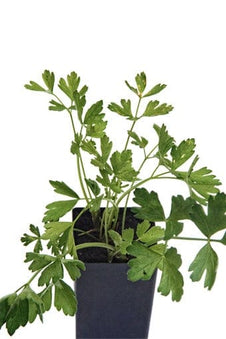



Parsley - Italian Parsley
Parsley - Italian Parsley

- In stock, ready to ship
- Inventory on the way

Usually available: All year
Life cycle: Annual
Height: 40 - 60cm
Position: Sun / part shade
Soil preference: Well drained
This is how we pack and send your Herb Plants to all states except TAS & WA
You will receive
- 1 Italian Parsley Herb Plant in a 50 X 75mm tube - General growing instructions
All of our Herb Plants are grown organically with certified organic potting mixes and fertilizers
Botanical Name: Petroselinum crispum var. neapolitanum
There are many varieties of parsley which grow as annuals, biennials or short lived perennials. The Neopolitan variety originally grew near Naples, in Italy. This variety may also be referred to as celery leafed parsley and is recognised by its longer stalks and many large flat leaves. The plant is bushy, a vigorous grower and like other parsleys it is quite hardy. Parsley varieties have a strong tap root and tall stems that develop stalks bearing clusters of tiny, yellow-green flowers during summer. The flowers produce small, oval shaped brown seeds.
Parsley is toxic and often fatal when consumed by birds, including parrots and poultry. However, other mammals seem to find it beneficial, with rabbits and other animals seeking the plant where it grows naturally. It is also highly valued as a healer of foot rot in sheep and goats. Parsley has been known for over 2000 years and in ancient times Anglo Saxons apparently used parsley to repair skulls that were fractured in battle. The Greeks held parsley in high esteem and used it as decorative crowns for winner of special sporting games and for tombs of their dead. They often planted parsley and rue as garden borders, which lead to the saying, “we are only at the parsley and rue”, when noting the beginning of an important problem solving process.
For other varieties of parsley, there may be slightly different uses and features to the leaves and stem, eg: curly leafed parsley.
Growing Conditions
Parsley is considered easy to grow, requiring a moderate amount of sunlight and capable of taking some shade. Having adapted to Mediterranean soils, parsley requires only a moderate amount of organic matter, but does require moist, well drained soils, especially to survive hot summers.
When grown in cooler conditions the plant is treated as an annual and can be grown inside in containers where there are frosts. In tropical regions, it is best to treat parsley as a cool season annual and replant each year.
Parsley grows from seed, with germination taking 6-8 weeks or more during the warm months. Seeds are best grown in trays, with seedlings being planted out after the first leaves appear. The plants can then be left to self-sow when they go to seed in the following year. Frequent pruning can help keep parsley productive until you have a regular crop of plants to pick new leaves from.
Parsley is susceptible to a number of pests, so keep watch for parsley worm, root-know nematode and carrot weevils that eat foliage, stunt growth and burrow into the top and root. They may also be affected by white fungal growth at the base of the plant, and crown rot, indicated by a brown crust on the soil surface.
Harvest parsley at any time by picking from the sides, because new growth comes from the centre of the stem. Parsley can be dried and frozen but each variety may perform differently in terms of taste and storage time.
Culinary Uses
Parsley has the distinction of being used frequently used as a garnish, but is rarely eaten. Despite this, parsley may be used for salads, dips, biscuits, crackers and is an essential part of the Lebanese dish tabbouleh. Leaves can be added to soups and stews, vegetable dishes, pies, eggs, stuffing and meat and poultry dishes. It works well with thyme and bay leaves, and is part of the French bouquet garni.
The Neopolitan parsley variety is grown for its long stems and these may be blanched and prepared in the same manner as celery. Although parsley is high in vitamins and mineral, most people do not eat enough to benefit from this nutritious herb. All parts of the plant are edible.
Medicinal Uses
Parsley is mostly known for its culinary use, however it does have a long history of medicinal uses and there is extensive information available on the internet. Some traditional uses include the roots as a mild diuretic and the seeds as a digestive aid. Medical research on the use of parsley ranges from exploration of benefits in tumour reduction to use in reduction of inflammation in rheumatoid and osteoarthritis. Parsley is contains luteolin which encourages the metabolism of carbohydrates and also has an anti-inflammatory benefit.
Parsley is rich in vitamins and minerals and contains flavonoids, which are valuable antioxidants. All parts of the plant can be used, but the chemical components apiol (camphor) and myristicin are uterine stimulants and can be toxic in large amounts. Some medical professionals advise that the seeds not be consumed in great quantity as they have higher percentages of the volatile oils.
Other Uses
Fresh parsley can also be used as a breath freshener.
Companion Plants
Parsley is a good companion plant to chives, carrots, corn, chilli, capsicum, onions, peas, tomatoes and asparagus. Parsley is said to improve the fragrance of roses and be a butterfly attractant.
Mint and lettuce are not good for parsley.
All information provided on this website is for informational purposes only. Please seek professional advice before commencing any treatment.






